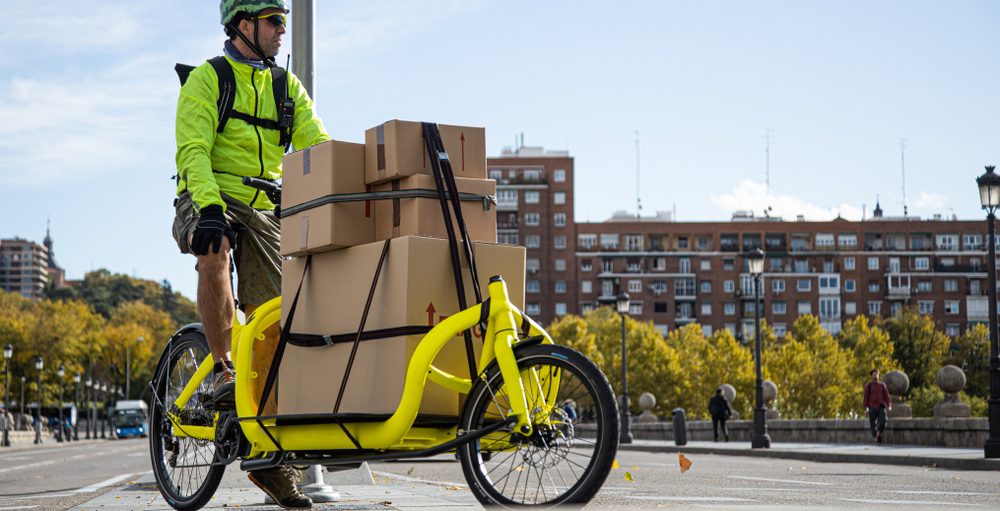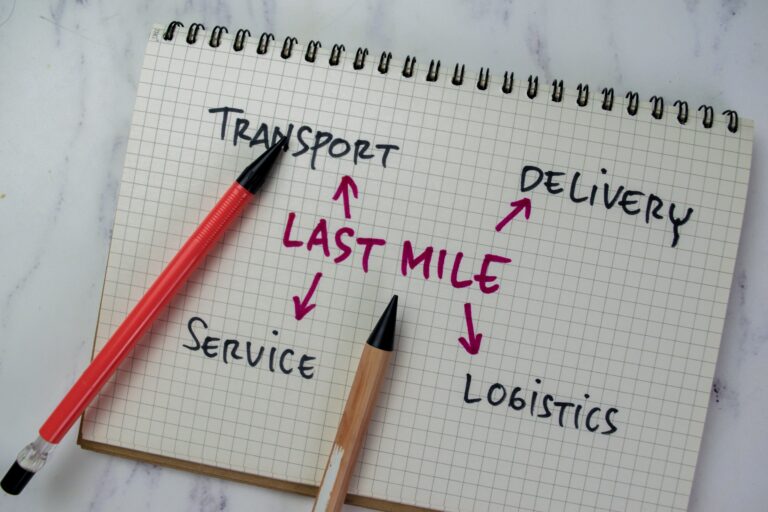The most challenging part of the logistics chain has always been the end: reaching consumers directly. It’s a step that urbanists refer to as the last mile, and it became a first priority for customers and businesses alike as the demand for e-commerce escalated with the Covid-19 pandemic.
At the same time, cities worldwide began significantly cutting back their dependence on cars (or cutting them out of the picture altogether!) in favour of more people-friendly streets, like Barcelona’s Superblocks and The Woonerf Concept in the Netherlands. While these dramatic, often very attractive changes in city topography can be sustainable and cost-effective solutions to some mobility issues in cities, in the process, they can also create new logistical issues, especially when it comes to the last mile.
Let’s explore what’s at stake with Philippe Lebeau, one of the authors of the EIT Urban Mobility Academy’s free ecourse on Last Mile Logistics to help us go the extra mile and understand how to make last mile logistics work harmoniously with pedestrianised streets.
A tricky balance between sustainability and necessity
The city of Brussels, where Philippe is based, began pedestrianising its historic centre in 2015. The initiative has since grown into a much more robust mobility project called the Good Move Pentagon that only allows motor vehicles to enter during specific time windows in the morning. The plans also altered circulation to restrict cars, vans and trucks to main streets or “big axes” to prevent them from shortcutting through the neighbourhood. When it comes to last-mile logistics, there are several pros and cons to consider…
“If you see it in a positive way,” Philippe says, “this enables a shift towards more sustainable transport like cargo bikes,” which can enter these zones throughout the day, as well as cut across the other infrastructure limitations. He explains that the project also “stimulates the use of micro hubs,” where trucks can make deliveries during the designated time frames and then the last mile can be achieved via the aforementioned cargo bikes or picked up directly by consumers at stores or other collection points by other sustainable transport methods.
The main challenge lies in how the Good Move Pentagon impacts the demand for commerce, which remains as high as ever. Philippe emphasises that “we still want to have this zone attractive to consumers, citizens and residents. So that means freight, and freight means transport.” Whereas transport operators used to have a much longer window of time to optimise their deliveries with one vehicle to multiple addresses, now they need more vehicles to meet the same demand in less time. Freight flows will continue to be fragmented as the city becomes less accessible to motorised vehicles — all of which “is actually just multiplying transport emissions,” in addition to making things more costly and clunky for transporters who keep their traditional logistics.
In short, as cities try to make their vision of sustainability a reality, it all comes down to innovation and adaptation so that these measures can be seen as an opportunity to organise last mile logistics distributions more sustainably. Congestion emissions from the continuing demand for goods and services must be offset in new ways in order for transporters to embrace fuel-free transport.
Sustainable logistics transport: Are cargo bikes a realistic solution?
Studies show that about half of last-mile trips could be switched to using bicycles when you consider the typical average weight of the items being transported and the distance travelled for such trips. While the potential remains huge, there are several drawbacks as well — and surprisingly, weather is not one of them. As Philippe clarifies, “You just need the right equipment and a good weather app. Usually, the number of regular cyclists doesn’t drop so much during the wintertime because it became a habit.”
Here’s instead what to consider with shifting last mile logistics to cargo bikes:
- Distance: “If you have long distances, then forget the bike. It’s really only for cities,” Philippe says. Bikes outperform vans for short distances but they can’t compete for efficiency and effectiveness with longer distances.
- Volume: Cargo bikes can carry a maximum of around 200 to 250 kilograms, although there are some trailers designed to slightly increase this capacity. Philippe observes that this “the reason why bikes are typically used for fragmented flows, where you have lots of small things to deliver, and why the potential for bikes is higher for the services trips than for the freight trips.”
- Cycling skills: Accidents are a major liability and not everyone knows how to ride a bike well, which makes it hard for big companies to make the switch. “You can’t force someone to go on a bike if he doesn’t have the skills,” says Philippe, “it needs to be on a voluntary basis.” This is why, typically, individual companies or entrepreneurs are more inclined to adopt cargo bike deliveries since they can independently contract experienced cyclists for the job.
Notably, service-related fields, such as plumbers and other maintenance workers have recognised the practicality of using cargo bikes for their work-related travel and embraced this significant change in transport. As Philippe explains, “They understood that it was much easier to move across the city by bike. They are faster, more reliable in their trip management and can park more easily. In some cases, they were previous cyclists and so they enjoy not being locked into their vans.” In other words, don’t be surprised if your internet technician comes by bike next time you give them a call.

Getting logistics and mobility on the same page
Even though the shift to sustainable last-mile transport reinforces the overall sustainability goals behind pedestrianised streets, logistics is often overlooked in the mobility space. Philippe emphasises that the core of transportation issues tends to be congestion, and most vehicles in traffic are unrelated to supply chains. “That’s the reason why most of the time,” he says, “the first measures target mobility and then solutions like pedestrianisation are only thought of from the perspective of mobility, not logistics.”
This point underscores the importance of taking different supply chain stakeholders’ views into account from the get-go, and that includes transporters as well as shippers and receivers. “But that’s the tip of the iceberg,” Philippe insists. Citizens are very important too, as are the local authorities behind Sustainable Urban Mobility Plans (SUMPs). In order for logistics to be successfully embedded into a city’s strategic plan, SUMPs need to go hand in hand with Sustainable Urban Logistic Plans (SULPs) so that, as Philippe insists, “mobility measures are supported and the last mile can be steered in the right direction. Otherwise, it will not work.”
Philippe shares two ways experts in Brussels like him are adapting last-mile logistics to the city’s new mobility plans. One has been extending the time windows on delivery at night when traffic is light to avoid congestion, while also making sure that the noise constraints are respected. “Night distribution is usually about delivering until midnight, but not at 2:00 a.m. It’s just about extending it a bit later at night and a bit earlier.” Originally, the approved slots were from 6 a.m. to 11 a.m., but now they begin at 4 a.m so that delivery fleets can reduce fragmented freight stops during the last mile by distributing their flow throughout available time windows.
The other focus is on e-commerce and giving everyday citizens the power to choose the most sustainable delivery method based on their location. For example, as Philippe says, “Delivering at home might be the most sustainable option in some more rural areas because the van that is delivering to you is making a ‘milk run’ so you don’t have to take your car to go to a far-away shop.” When it comes to city dwellers, most of the time, the most sustainable option is getting your parcel delivered to a nearby locker box. “You pick it up because you’re going there anyway and it’s one central point where the truck can consolidate deliveries.” In both of these cases, transport is simple and optimised.
However, sometimes the most sustainable solution isn’t so straightforward: “Depending on the way you get your goods delivered,” Philippe says, “ecommerce can be less sustainable than going to a brick and mortar store.” That’s because you have to take into account where the store is and how you would be getting there. Given these often complicated factors, Philippe’s research group VUB Mobilise teamed up with VIL to create a tool called Smart Drop. The site calculates how elements like fuel, pollution, potential for accidents and more translate into externalities or cash costs that affect how both retailers and consumers affect the last mile.
This is not the last time you’ll hear from the EIT Urban Mobility Academy about logistics. Learn more about this topic, as well as Sustainable Urban Logistics and more with our free, self-paced courses online.

Adina Rose Levin
Adina Levin was born and raised in Chicago, and clocked in over 10 years in New York City before moving to Barcelona. As a freelance writer and creative strategist, she explores cities, culture, media and tech.

Philippe Lebeau
Prof. Dr. Philippe Lebeau is teacher and researcher at the Vrije Universiteit Brussel. He is co author of EIT Urban Mobility Academy´s Last Mile Logistic online course.





